TSPO
-
Official Full Name
translocator protein (18kDa) -
Overview
Present mainly in the mitochondrial compartment of peripheral tissues, BZRP interacts with some benzodiazepines and has different affinities than its endogenous counterpart. The protein is a key factor in the flow of cholesterol into mitochondria to permit the initiation of steroid hormone synthesis. -
Synonyms
TSPO;translocator protein (18kDa);benzodiazapine receptor (peripheral) , BZRP;translocator protein;DBI;IBP;MBR;mDRC;PBR;peripheral type benzodiazepine receptor/recognition site;pk18;PKBS;mitochondrial benzodiazepine receptor;benzodiazepine peripheral binding site;peripheral-type benzodiazepine receptor;PBS;BPBS;BZRP;PTBR
Recombinant Proteins
- Human
- Zebrafish
- Mouse
- Rhesus macaque
- Chicken
- Rat
- Bovine
- Mus musculus
- Arabidopsis thaliana
- Sheep
- Sus scrofa (Pig)
- Pig
- E.coli
- Mammalian Cells
- HEK293
- His
- GST
- T7
- DDK
- Myc
- Non
- Flag
- Avi
- Fc
- SUMO
Background
What is TSPO protein?
TSPO gene (translocator protein) is a protein coding gene which situated on the long arm of chromosome 22 at locus 22q13. TSPO, also known as the Peripheral Benzodiazepine Receptor (PBR), is a transmembrane protein located primarily in the outer membrane of the mitochondria. It plays a role in a variety of biological functions, such as steroid biosynthesis and mitochondrial function regulation. TSPO proteins are highly conserved during evolution and are highly expressed in neuroinflammatory cells such as activated microglia. In addition, TSPO is also involved in the regulation of cellular inflammatory response, oxidative stress and mitochondrial homeostasis. The TSPO protein is consisted of 169 amino acids and TSPO molecular weight is approximately 18.8 kDa.
What is the function of TSPO protein?
The TSPO protein, or mitochondrial transporter, is a protein that plays a role in a variety of cellular functions, including steroid biosynthesis, apoptosis, cell proliferation, differentiation, regulation of mitochondrial function, and porphyrin transport. It is primarily located in the mitochondrial outer membrane and is associated with the introduction of cholesterol into the mitochondria, a key step in steroid production. In addition, TSPO proteins are involved in the formation of mitochondrial permeability transition pore (mPTP), which plays an important role in apoptosis and cellular stress response. In the heart, TSPO proteins may play a key role in regulating physiological heart function, and TSPO ligands may act as drugs to protect the heart under pathological conditions.
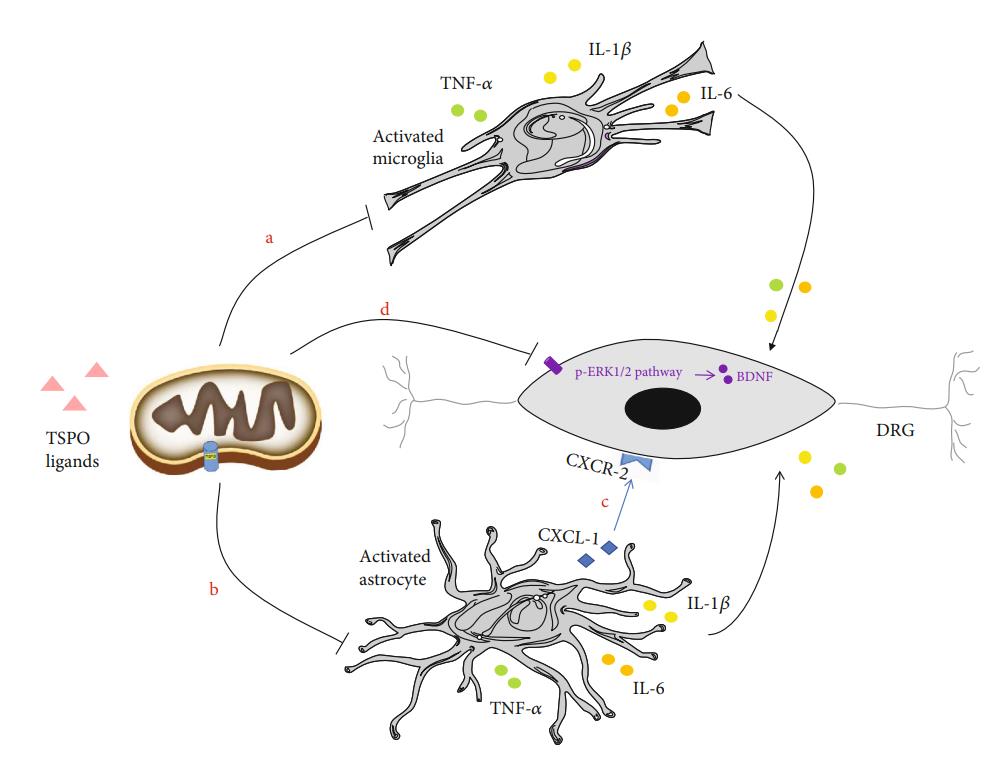
Fig1. Molecular mechanisms by which TSPO and TSPO ligands inhibit chronic pain induced by peripheral nerve injury. (Jie Liu, 2022)
TSPO Related Signaling Pathway
TSPO proteins bind cholesterol with high affinity on the mitochondrial outer membrane and are involved in cholesterol transport to the inner mitochondrial membrane, which is a key step in steroid synthesis. TSPO is related to the regulation of mitochondrial function, affecting the permeability of mitochondrial membrane and the oxidative stress response of mitochondria. In the heart, TSPO may play a key role in regulating physiological cardiac function, and TSPO ligands may be used as drugs to protect the heart under pathological conditions. TSPO may be involved in regulating mitochondrial reactive oxygen species (ROS) levels to combat oxidative stress. TSPO is highly expressed as a biomarker in neuroinflammation, especially in activated microglia, and is associated with the regulation of inflammatory response, oxidative stress and mitochondrial homeostasis.
TSPO Related Diseases
TSPO proteins are associated with a variety of diseases, especially those involving neuroinflammatory and neurodegenerative changes. In neuroinflammation, TSPO as a biomarker is enhanced in activated microglia and is associated with acute and chronic neuroinflammation. In addition, TSPO levels increase in neurodegenerative diseases such as Alzheimer's disease, Parkinson's disease, multiple sclerosis, driven by peripheral inflammatory cell infiltration and glial cell activation. TSPO may also play a role in psychiatric disorders, such as in major depression, where TSPO ligands exert antidepressant and anti-anxiety properties by promoting endogenous neurosteroid synthesis. Postoperative cognitive impairment (now known as perioperative neurocognitive impairment) has also been associated with upregulation of TSPO expression, which inhibits mitochondrial autophagy and leads to the accumulation of dysfunctional mitochondria. In addition, TSPO is associated with cardiovascular disease, nerve damage, certain forms of epilepsy, peripheral neuropathy and other neurodegenerative diseases.
Bioapplications of TSPO
The application of TSPO protein is mainly concentrated in the field of medical research and clinical diagnosis, especially in the study of neuroinflammatory and neurodegenerative diseases. Because TSPO is highly expressed in activated microglia during neuroinflammation, it has become a biomarker for evaluating inflammatory activity in the brain. Using TSPO's radioactive ligands, positron emission tomography (PET) technology can be imaged in vivo to help detect and monitor the occurrence and progression of neuroinflammation. In addition, TSPO ligands have potential applications in drug development, where they may exert antidepressant and anti-anxiety properties by promoting endogenous neurosteroid synthesis, providing new strategies for the treatment of psychiatric disorders. In drug screening and toxicity testing, TSPO ligands are also used as tool compounds to help evaluate the potential effects of drugs on the nervous system.
Case Study
Case Study 1: Junchao Tong, 2020
Positron emission tomography (PET) imaging of the translocator protein (TSPO) is widely used as a biomarker of microglial activation. However, TSPO protein concentration in human brain has not been optimally quantified nor has its regional distribution been compared to TSPO binding. Researchers determined TSPO protein concentration, change with age, and regional distribution by quantitative immunoblotting in autopsied human brain. Brain TSPO protein concentration was higher than those reported by in vitro binding assays by at least 2 to 70 fold. TSPO protein distributed widely in both gray and white matter regions, with distribution in major gray matter areas ranked generally similar to that of PET binding in second-generation radiotracer studies. TSPO protein concentration in frontal cortex was high at birth, declined precipitously during the first three months, and increased modestly during adulthood/senescence. As expected, TSPO protein levels were significantly increased in degenerating putamen in multiple system atrophy, providing further circumstantial support for TSPO as a gliosis marker.
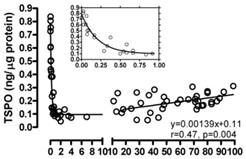
Fig1. Aging and neonatal developmental changes of levels of TSPO in autopsied human brain.
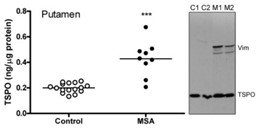
Fig2. Increased levels of TSPO protein in putamen of patients with multiple system atrophy (MSA) as compared to control subjects.
Case Study 2: Nadja Blum, 2023
Meningiomas are the most common primary intracranial tumors and show extensive infiltration of macrophages. The mitochondrial membrane protein translocator protein (TSPO) has been used as an in vivo marker of microglia and macrophage activation to visualize neuroinflammation. However, it is unknown which cell types express TSPO in meningiomas. Immunohistochemistry of 38 WHO grade 1-3 meningiomas was subjected to segmentation and deep learning classification of TSPO expression to either Iba1-positive tumor-associated macrophages (TAMs) or all other (mainly neoplastic) cells. A possible association between clinical data and TSPO expression intensities was also investigated. TAMs accounted for 15.9%-26% of all cells in the meningioma tissue. Mean fluorescence intensity of TSPO was significantly higher in TAMs, but the mass of neoplastic cells in the tumors exceeded that of TAMs. Thus, the summed fluorescence intensity of TSPO in meningioma cells was 64.1% higher than in TAMs.
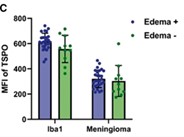
Fig3. Bar graphs for patients with or without peritumoral edema in relation to MFI of TSPO.
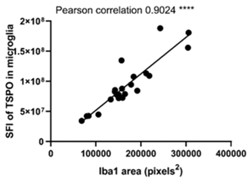
Fig4. A near perfect correlation between the SFI of TSPO in microglia.
Quality Guarantee
High Purity
.jpg)
Fig1. SDS-PAGE (TSPO-1696H)
.
.jpg)
Fig2. SDS-PAGE (TSPO-142HFL)
Involved Pathway
TSPO involved in several pathways and played different roles in them. We selected most pathways TSPO participated on our site, such as Neuroactive ligand-receptor interaction,HTLV-I infection, which may be useful for your reference. Also, other proteins which involved in the same pathway with TSPO were listed below. Creative BioMart supplied nearly all the proteins listed, you can search them on our site.
| Pathway Name | Pathway Related Protein |
|---|---|
| Neuroactive ligand-receptor interaction | AGTR1B,P2RY10,LHCGR,NPY1R,GABRG2,TACR1,PTGFR,PTGIR,PLG,TRHR |
| HTLV-I infection | NFATC1,MSX1,DLG1,TERT,GSK3B,PPP3CC,VDAC1,POLE,HLA-E,MYBL2 |
Protein Function
TSPO has several biochemical functions, for example, androgen binding,benzodiazepine receptor activity,cholesterol binding. Some of the functions are cooperated with other proteins, some of the functions could acted by TSPO itself. We selected most functions TSPO had, and list some proteins which have the same functions with TSPO. You can find most of the proteins on our site.
| Function | Related Protein |
|---|---|
| protein binding | SUGP1,RTN4RL1B,RPSA,KRTAP12-1,EXOC3-AS1,CD274,PRSS3,GRIN1,DAO,C11orf57 |
| cholesterol binding | CETP,OSBPL1A,APOA1A,SCP2,TSPO2,APOA2,STARD3,APOA5,APOA4B.1,OSBPL7 |
| benzodiazepine receptor activity | GABRA2,GABRG2,GABRA6,GABRA4,GABRA3 |
| androgen binding | SHBG,ALDH1A1,Ar |
Interacting Protein
TSPO has direct interactions with proteins and molecules. Those interactions were detected by several methods such as yeast two hybrid, co-IP, pull-down and so on. We selected proteins and molecules interacted with TSPO here. Most of them are supplied by our site. Hope this information will be useful for your research of TSPO.
Resources
Related Services
Related Products
References
- Jensen, P; Kondziella, D; et al. Anti-NMDAR encephalitis Demonstration of neuroinflammation and the effect of immunotherapy. NEUROLOGY 84:859-859(2015).
- Azarashvili, T; Baburina, Y; et al. Carbenoxolone induces permeability transition pore opening in rat mitochondria via the translocator protein TSPO and connexin43. ARCHIVES OF BIOCHEMISTRY AND BIOPHYSICS 558:87-94(2014).



